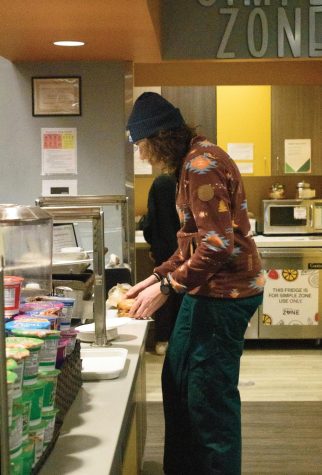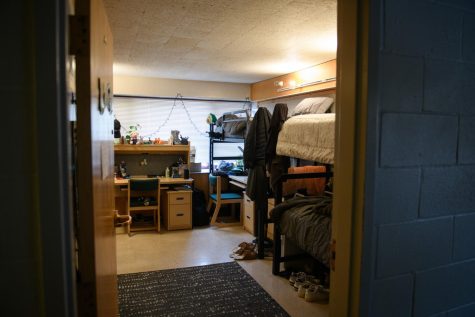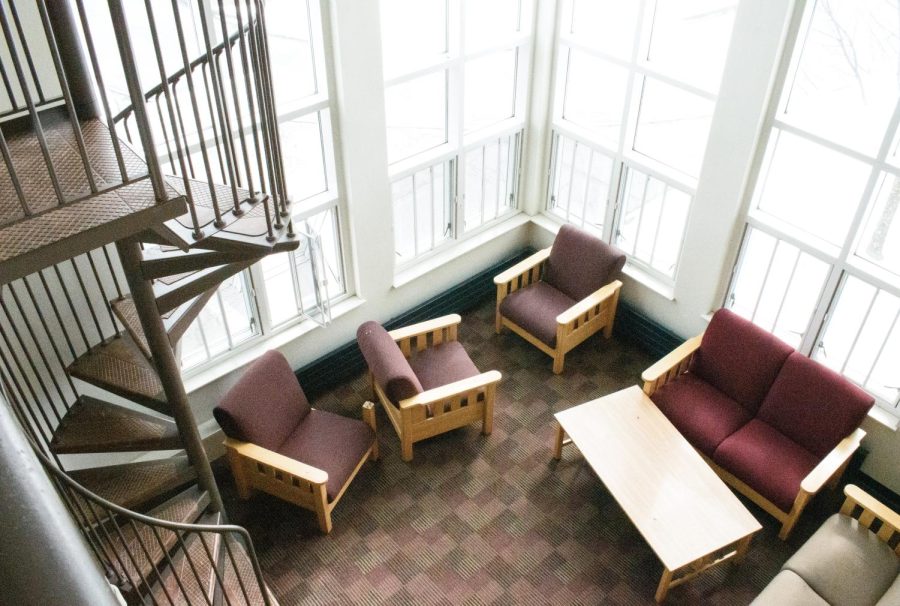A University Heights common room with a spiral staircase March 8. Students have been noting discrepancies between different residential halls and campuses in light of ResLife’s new room selection system.
“100% there are discrepancies between campuses:” Students express mixed feelings over UVM housing
March 23, 2023
Editor’s Note: This story was updated April 12 at 3:13 p.m. to reflect new information provided by ResLife about the fall 2023 housing selection process for incoming sophomores.
As the housing selection process for next fall approaches, first-year students have begun thinking about where they want to live on campus next year.
UVM’s four residential campuses—Athletic, Trinity, Redstone and Central—can offer students different experiences based on their Learning Community, according to UVM’s website.
However, some students have noted the differences in quality of housing between campuses.
Charles Holmes-Hope, director of Residential Life, did not respond to the Cynic’s multiple requests for comment on this issue.
Student’s opinions on housing quality
“I’ve met some really cool people who are really passionate about art,” said first-year Muriel Celia, who lives on Trinity campus in the Arts & Creativity Learning Community. “But I would like to be surrounded by more of the UVM-general campus experience and be closer to things.”
Felicia Conneely-Nolan, a junior living on Redstone campus, said she’s enjoyed the two years she’s spent on campus.
“I like the building that I live in because it’s connected to the Redstone Market, and it’s connected to the dining hall,” Coneely-Nolan said. “I like the parking there. There are always spots to park your car, which is really nice.”
First-year Kaley Frascogna lives on Central campus and expressed a similar sentiment.
“I’m proud to live here,” Frascogna, a resident of Central Campus Residence Hall, said. “People always compare us [to] a hotel. It’s just really modern and nice.”
However, Frascogna said she does not want to live on Central again, largely due to the quality of the sophomore Wellness Environment dorms located in Converse Hall.
“We don’t really want to live in Converse just because [of] the dorms, they’re horrible,” Frascogna said. “I hear nightmares about the Converse dorms, and if I stayed in Wellness, I would live in Converse.”
Converse Hall has a history of damage in rooms and poor living conditions, including flooding and pests, according to an Oct. 16, 2018 Vermont Cynic article.
Coneely-Nolan also noted damages as a drawback to Redstone campus.
Early in the fall 2022 semester, students living on Redstone were charged fees as a result of “unassigned damages,” according to a Feb. 9 Vermont Cynic article.
The damages included broken ceiling tiles and emergency telephones in Simpson Hall, according to the Cynic article.
Coneely-Nolan, who lives in Hamilton Hall, said that while the damages didn’t affect her personally, she did find the constant mess to be disheartening.
“[It’s] annoying to see basically garbage everywhere from things that were just destroyed,” she said.
Coneely-Nolan expressed that this was a unique living situation to be in.
“There’s not as much communal respect,” she said. “It’s just odd to live in an environment like that because growing up in [my family’s house], obviously you don’t wake up and stuff is broken everywhere.”
Celia thought her dorm was fine for her first year, but was also concerned with the quality of her dorm if she were to live on Trinity again.

Frascogna acknowledged there are glaring differences in the quality of housing depending on the campus that a student lives on.
“Comparing Central and Redstone, you could just tell [CCRH was] built in 2017, so they’re just a lot better quality,” Frascogna said.
Coneely-Nolan felt similarly that there are inequalities in the quality of housing between campuses.
“I would say 100% that there are discrepancies between campuses,” she said.
Celia also discussed the significant differences between facilities and access to amenities between campuses.
“I think UVM could do a better job in making sure more underprivileged dorms are given some similar amenities to those that are either more central on campus or have better facilities,” Celia said. “For example, adding a functioning, fully-fledged dining hall on Trinity or giving us access to a gym.”
Changes in the housing selection process
Celia, Frascogna and Coneely-Nolan all expressed anxiety that this inequality in housing might be exacerbated by the updated housing selection process for next year.
Previously, housing selection was done by having buildings assigned to each Learning Community. Students would rank their preference of Learning Community and have the choice of a room within their LC buildings, Coneely-Nolan said.
Initially many first-year students thought the time slots would be assigned based on both AP and Dual Enrollment credits and credits taken at UVM due to ambiguity on UVM’s website. Housing selection is actually assigned based on credits solely taken at UVM, according to an April 4 email from ResLife.
“[Housing selection] is only based on UVM earned credits to ensure equity and not favor students who may have had greater access to AP or dual enrollment courses at their respective high schools,” the email stated.

Coneely-Nolan believes deciding where to live on campus is about more than just choosing a building and a room.
“That’s a very personal situation, a very personal choice that impacts pretty much every aspect of your daily life on a college campus,” she said.
Coneely-Nolan also expressed overall dissatisfaction with ResLife, its practices and housing on campus.
“I would say in my personal experience, I don’t know that ResLife has adequately adhered to people’s needs as far as housing, issues with housing and things that arise for people, which is kind of disappointing.”
